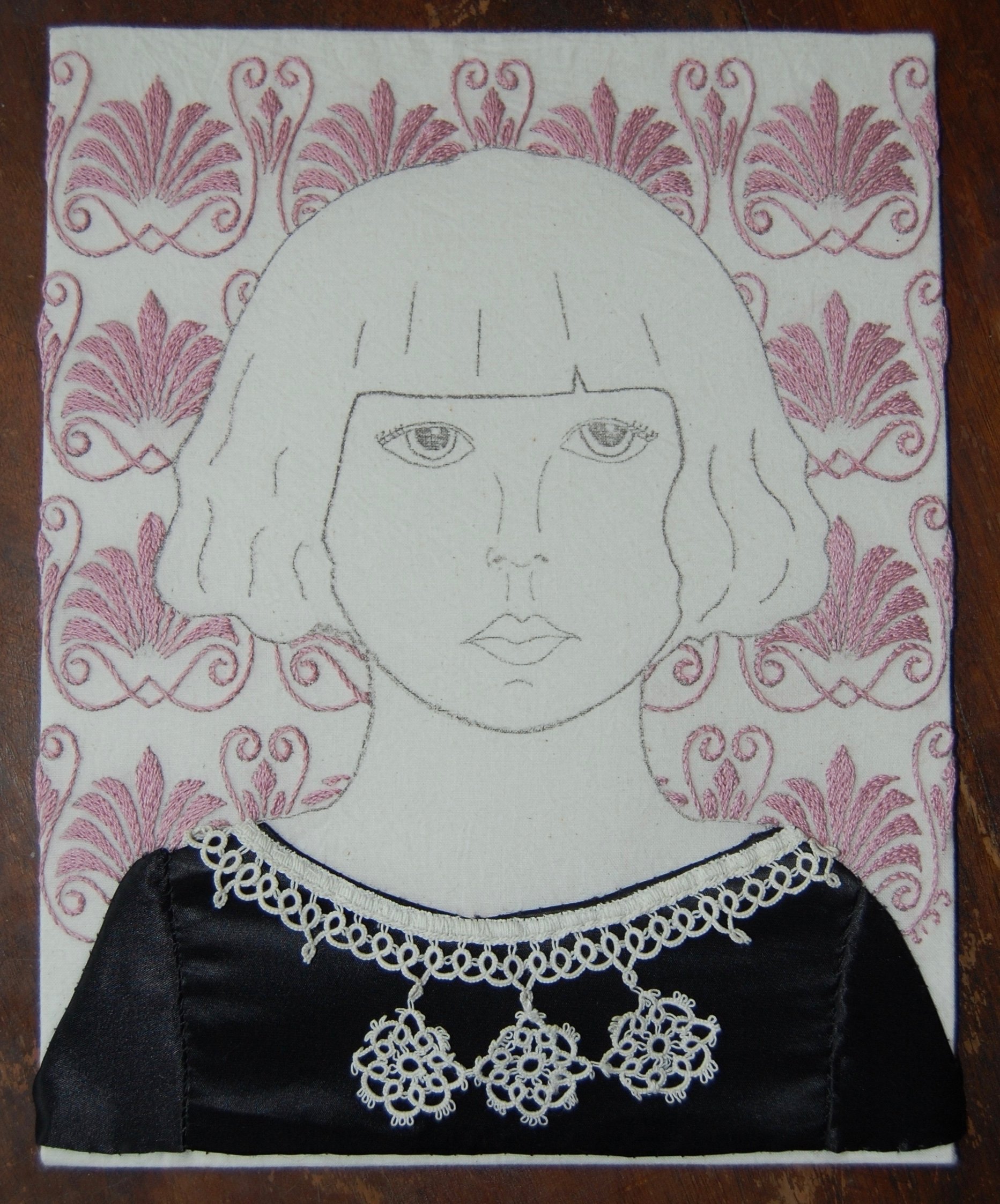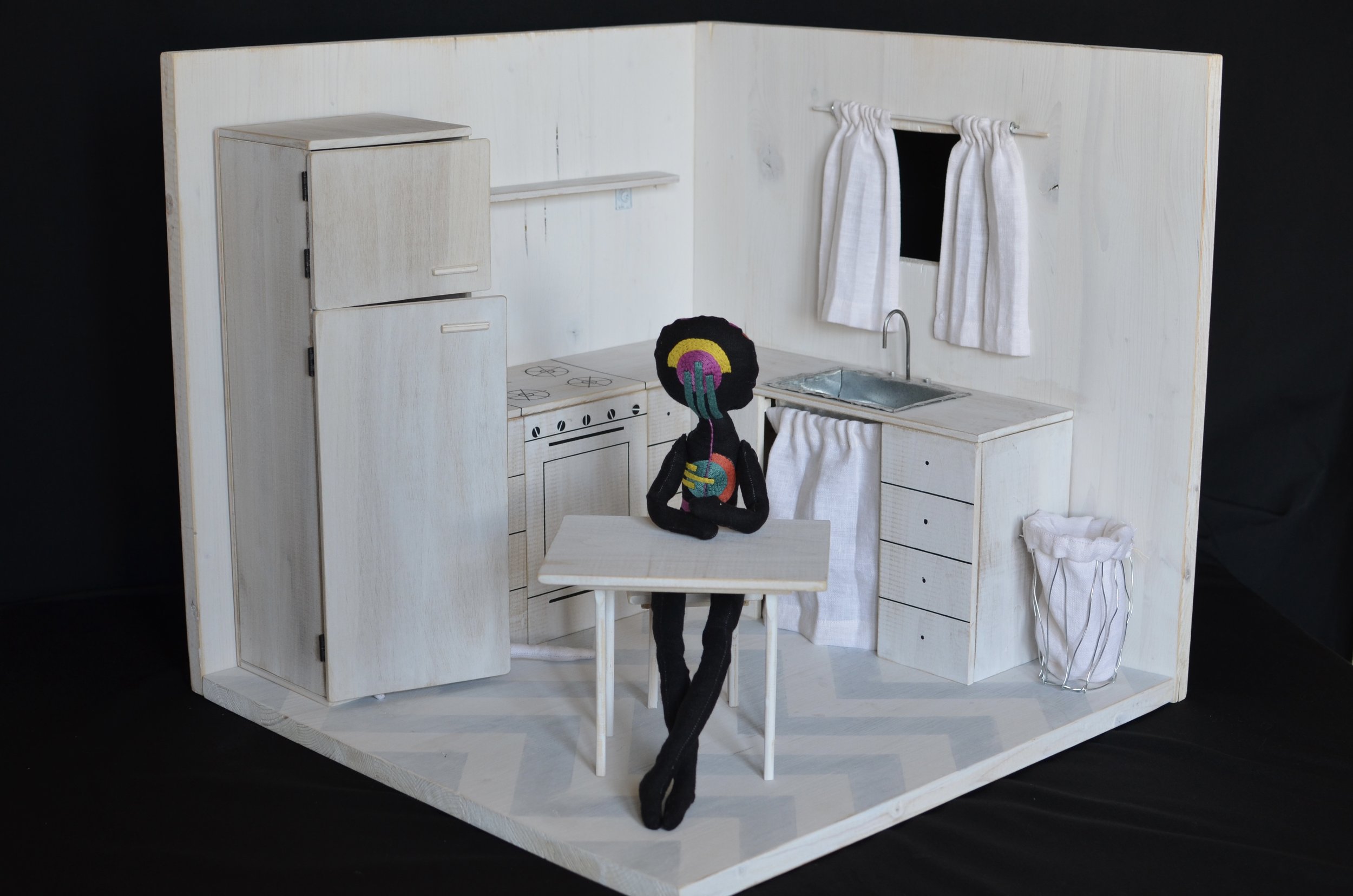Carrie Cooper
Hello! My name is Carrie and I’m a mixed-media fiber artist living in the Pacific Northwest. I work mainly in embroidery, often incorporating soft-sculpture, wood-working, paint, image-transfer, photography and stop-motion video into my studio practice. In the past year my work has gone from two dimensional to three dimensional, focusing on “partial dioramas” (or “Isolated Figures” as I’ve begun calling them) that explore the complexity of personal ident ty within the context of domesticity and societal expectations. I’m interested in how feelings of otherness and not belonging impact daily interactions and functioning in “normal” society. I’ve always felt that the expressive, textural nature of needle-work and fiber art has a unique, communicative quality that is especially conducive to contemporary art-making. My aim is to help expand the perception of these traditional craft techniques to the realm of contemporary art. I find inspiration in the absurdity and sadness of life, in color and juxtaposition. Thank you
Carrie Cooper resides in Bellingham, Washington, USA and holds a Masters in Teaching Secondary Art from Western Washington University. She has exhibited her work throughout Washington State, as well as Chicago and New York City. She is currently a juror and curator for Make. Shift Art Space in Bellingham and enjoys a daily art practice.
Penetration 1/2017, Embroidery floss on linen, 12"x9" (approx), $175
Girl Portrait 1/2012, Ink, embroidery floss, satin, lace on recycled cotton, 8.5"x11", SOLD
Unravel 1/2013, Ink and embroidery floss on recycled cotton, 8.5"x11", SOLD
No-Tell Motel/2016, Ink and embroidery floss on recycled cotton, 12"x10", SOLD
Selfie House (bathroom detail)/ 2017, Embroidery floss on linen, 12"x9", SOLD
The Gym/2018, Embroidery floss on linen, 11"x14", SOLD
Isolated Figure 2 / 2020, Linen, embroidery floss, wire, wood, paint, 24"x24"x11", $500
Isolated Figure 3 / 2020, Linen, embroidery floss, wood, paint, 14"x14"x14", $400
Isolated Figure 4 / 2020, Linen, embroidery floss, wire, wood, 18.5"x10.5"x14", $400
Isolated Figure 5 / 2020, Linen, embroidery floss, wire, wood, iPhone, rotoscope animation, 14"x14"x11.5", $400
Isolated Figure 6 / 2021, Linen, embroidery floss, wood, paint, 24"x13"x22", $400
Isolated Figure 7 / 2021, Linen, embroidery floss, wire, metal, wood, paint, 21"x21"19", $600
Stay Inside / 2020
Stop-motion animation with soundtrack by Kurt Sterzelbach
Coping / 2021
Stop-motion animation
Joined / 2020
Stop-motion animation
You’re a new addition to the crayon box: what color are you?
Yves Klein Blue! Is that a pretentious answer? It might be a little pretentious. But I love vibrant blues, and his is one of those.
What is your earliest memory of art?
Unfortunately my first memory of art was probably when my kindergarten teacher made me stay inside during recess to remake my construction-paper “valentine man” because he was “too long and skinny.” This taught me at an early age the vulnerability and risk of showing one’s creations to others.
How did you become a practicing artist?
I always longed to be a creative person, but for a long time I was paralyzed by deep insecurities, as well as uncertainty about the type of art I wanted to make. Drawing didn’t come easily to me as a kid (it still doesn’t), and I foolishly believed that meant I would never be a “real artist.” It didn’t help that both my parents were artists and drawing and painting seemed so easy for them. Sadly, I pretty much gave up on art-making when I was a child, even though the longing to create persisted. It wasn’t until my early 30’s when I finally realized that artistic skills are something you work at - rarely are they a gift you’re anointed with at birth - and that “art” can be so much more than the holy trinity of painting, drawing, and sculpture. I displayed my first embroidery piece in a group gallery show at the age of 34 and have been a practicing artist ever since.
How did you come to start working with embroidery?
In 2006 I visited my mom and asked her to teach me to embroider because I wanted to make my friend a personalized pillow. I instantly fell in love with the tactile nature of embroidery floss on fabric and how egalitarian and forgiving of an art form it is. I continued embroidering silly little pillows and pictures for friends, then eventually started using it as a means of self-expression and art-making.
Tell us a little about your Isolated Figure series.
As I mentioned, my background is in 2D embroidery, so this series was a departure from my skillset and was super challenging, but in a good way (I’d never worked with electric hand tools before!). When I was a little girl, I was obsessed with playing Barbie’s and I would spend hours in my bedroom creating living spaces for them that were unique to the personalities and background stories I’d give them. I think the Isolated Figures series was born out of this love of creating miniature spaces. They were also born out of a need to express feelings of otherness and not belonging. I think most creative people have, at one time or another, felt like an outsider in a world that doesn’t make a lot of sense to them. There’s sadness and loneliness in that, but there’s also beauty, and that’s what I’m hoping to convey in this series.
Can you name three other artists who have inspired your work?
Ugh, there’s so many, it’s hard to choose just three! Marisol Escobar’s wood sculptures and Louise Bourgeois’ fiber sculptures are definitely an inspiration. And although she’s not a visual artist, I’ve been obsessed with the Welsh singer-songwriter, Cate Le Bon’s songs, style and music videos lately.
What is your favorite tool(s) to create with?
Needle, embroidery floss, linen.
What's the best piece of advice you’ve received?
My dad passed away in 2013 and I recently found a book he’d given me after I was accepted into grad school with a hand written note inside that said, “Let your imagination flow and feel free to borrow and be inspired by other artists. But try to maintain your own unique vision.” Still good advice.
What does a typical studio day look like for you?
For the Isolated Figure Series, it’s been really varied - I’m either in my garage cutting, sanding and glueing wood pieces, etc., or I’m on the couch embroidering the figure’s head and bodies, or in my studio sewing the figures together. Currently I’m taking a little break from the dioramas to concentrate on 2D embroidery, so a typical “studio” day consists of sitting on the couch embroidering while watching copious amounts of horror and sci-fi.
How has quarantine changed your practice?
With all the suffering in the past couple years, I feel a little guilty admitting that the beginning of the pandemic was a fruitful period for me creatively. I was a substitute teacher, so when schools closed I was able to be in the studio full time. Without this concentrated period in the studio, I doubt I would have produced as many Isolated Figures as I have (all of my work - both 2D and 3D - takes a while to make). Now that I have a full time job and things are getting back to “normal,” I’m trying to maintain the motivation and discipline I had before, but it’s a challenge.













